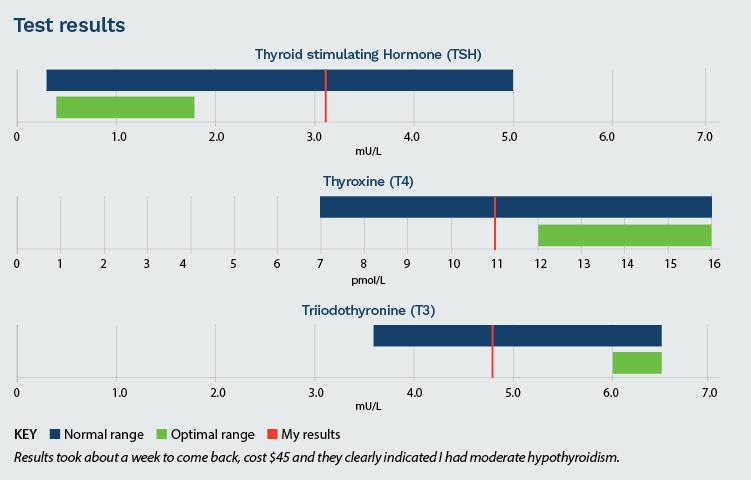When I booked last year to have my health checked by an Auckland naturopath, he asked me to do an early morning body temperature check for 10 days. This was probably because one of my health goals was to have warm hands at all times. When I shake hands with other people, my hands are nearly always cooler than theirs. So I duly did my 10 day average body temperature check and found it was half a degree lower than expected, 36.2° instead of the normal temperature of 36.7°.
What the naturopath found
When I visited the naturopath he studied my face then told me I had the classic sign of an underactive thyroid – eyebrows thinning towards the outside edges. Later he gave me a Thyroid Reflex test which measured zero – another indicator he said of an underactive thyroid.
I did suspect I had an underactive thyroid, called hypothyroidism (hypo means low). Hypothyroidism goes mostly undiagnosed and affects thousands of New Zealanders, mostly women. It can profoundly affect both the body and mind. About 15% of the New Zealand population are thought to be affected and currently 70,000 take thyroid medication.
Signs of an underactive thyroid
Clinical signs of a low thyroid output are low body temperature, thinning outer eyebrows, dry skin and hair, easy weight gain, cold hands and feet, excessive sleepiness, brain fog, poor memory and sore joints. I currently tick many of those boxes.
The minerals iodine, selenium and zinc are necessary for good thyroid function (all are lacking in the New Zealand diet) along with iron. However I felt that my mineral intake was more than adequate, especially iodine and wondered why I should have this problem.
I had my thyroid levels tested
It took me six months after the naturopath visit to have my thyroid medically checked. I finally plucked up enough courage to overcome my fear of needles and drove to my local Tauranga Pathlab agency. There I submitted my arm to the nurse for a blood extraction, closed my eyes and found it wasn’t as traumatic as I had feared. She sent my blood sample off to test for the three main thyroid hormones;
TSH - the regulating hormone
Thyroxine (T4) - the base hormone
Triiodothyronine (T3) - the most active hormone

Standard TSH test not reliable
Most doctors rely on a TSH test alone to diagnose hypothyroidism, but nearly everybody with an underactive thyroid will test within the normal range, just as I did. So it’s best to insist on the full 3 part test and use the optimal range.
Triiodothyronine (T3) is the critical hormone – when prescribed this hormone, symptoms usually disappear.
As all my test results were outside optimal levels, I briefly thought about taking a Triiodothyronine tablet, but as I like living without medication I thought better of it.
Not long afterwards, while I was begining to draft this article, I remembered the results of another test I had that reported my iodine levels were too high
So I did some research on ‘hypothy-roidism and excess iodine’ and immediately found my answer. Evidently hypothyroidism from excess iodine is common among people that eat a lot of iodine rich seaweed. It is called the ‘Wolff-Chaikoff effect’ named after the two doctors who reported their findings in 1948. Researchers are still puzzled as to why it happens, but it does and this seemed to be my problem.
The RDI (Recommended Daily Intake) for iodine is 150mcg a day, but in addition to the 100mcg in my daily CAA capsule, I was also adding a heaped teaspoon (6gm) of iodine rich New Zealand kelp to my vegetables each week. I calculated I could be taking as much as 14,000mcg of iodine a day, well over the 1100mcg recommended maximum. No wonder my eyebrows were thinning at the edges and my skin and hair were also getting drier.
So I’ve decided to just stick with my daily CAA capsule for my iodine intake and see what happens. It takes up to 8 weeks for excess iodine to be flushed from the body. I’ll report back in a future catalogue – hopefully by then, with full eyebrows and warm hands.
Follow-up to David’s low thyroid problem
For readers who read my last catalogue article on my underactive thyroid problem (hypothyroidism), here’s a quick follow-up.
Now that I’ve stopped adding a large amount of iodine-rich New Zealand kelp to my food, I’m slowly but surely noticing an improvement. I wake up warmer than before, I’m less drowsy during the day, the skin on my face is no longer dry and my eyebrows are beginning to thicken up at the outer edges, just like in photos taken when I was 15 years younger. It feels good to successfully treat the cause of a disorder rather than the symptom.
I’m now working on my big toe joint problems with some success. I’ll report on that at a later date.